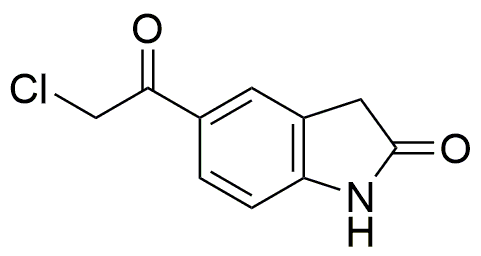5-(Chloroacetyl)oxindole is widely utilized in research focused on:
- Pharmaceutical Development: This compound serves as a building block in the synthesis of various pharmaceuticals, particularly in the development of anti-cancer agents due to its ability to modify biological pathways.
- Organic Synthesis: It is employed in organic chemistry for creating complex molecules, allowing researchers to explore new chemical reactions and develop innovative compounds.
- Biological Research: The compound is used in studies investigating its biological activity, helping scientists understand its effects on cellular processes and potential therapeutic applications.
- Material Science: 5-(Chloroacetyl)oxindole can be incorporated into polymer systems, enhancing material properties for applications in coatings and adhesives.
- Agrochemical Formulations: It is explored for its potential in developing agrochemicals, contributing to the creation of more effective pesticides and herbicides that can improve crop yields.
General Information
Properties
Safety and Regulations
Applications
5-(Chloroacetyl)oxindole is widely utilized in research focused on:
- Pharmaceutical Development: This compound serves as a building block in the synthesis of various pharmaceuticals, particularly in the development of anti-cancer agents due to its ability to modify biological pathways.
- Organic Synthesis: It is employed in organic chemistry for creating complex molecules, allowing researchers to explore new chemical reactions and develop innovative compounds.
- Biological Research: The compound is used in studies investigating its biological activity, helping scientists understand its effects on cellular processes and potential therapeutic applications.
- Material Science: 5-(Chloroacetyl)oxindole can be incorporated into polymer systems, enhancing material properties for applications in coatings and adhesives.
- Agrochemical Formulations: It is explored for its potential in developing agrochemicals, contributing to the creation of more effective pesticides and herbicides that can improve crop yields.
Documents
Safety Data Sheets (SDS)
The SDS provides comprehensive safety information on handling, storage, and disposal of the product.
Product Specification (PS)
The PS provides a comprehensive breakdown of the product’s properties, including chemical composition, physical state, purity, and storage requirements. It also details acceptable quality ranges and the product's intended applications.
Certificates of Analysis (COA)
Search for Certificates of Analysis (COA) by entering the products Lot Number. Lot and Batch Numbers can be found on a product’s label following the words ‘Lot’ or ‘Batch’.
Numéro de catalogue
Numéro de lot/série
Certificates Of Origin (COO)
This COO confirms the country where the product was manufactured, and also details the materials and components used in it and whether it is derived from natural, synthetic, or other specific sources. This certificate may be required for customs, trade, and regulatory compliance.
Numéro de catalogue
Numéro de lot/série
Safety Data Sheets (SDS)
The SDS provides comprehensive safety information on handling, storage, and disposal of the product.
DownloadProduct Specification (PS)
The PS provides a comprehensive breakdown of the product’s properties, including chemical composition, physical state, purity, and storage requirements. It also details acceptable quality ranges and the product's intended applications.
DownloadCertificates of Analysis (COA)
Search for Certificates of Analysis (COA) by entering the products Lot Number. Lot and Batch Numbers can be found on a product’s label following the words ‘Lot’ or ‘Batch’.
Numéro de catalogue
Numéro de lot/série
Certificates Of Origin (COO)
This COO confirms the country where the product was manufactured, and also details the materials and components used in it and whether it is derived from natural, synthetic, or other specific sources. This certificate may be required for customs, trade, and regulatory compliance.


